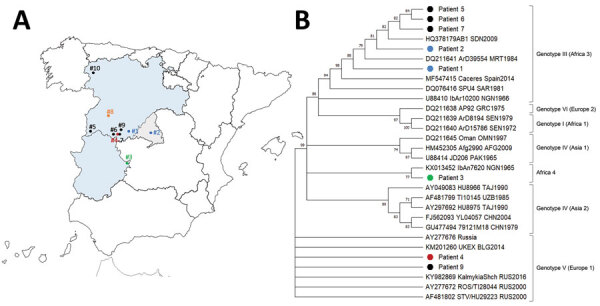Figure 1.

Locations of CCHF cases (A) and phylogenetic tree of CCHFV (B) in Spain, 2013–2021. Dots on the map indicate patients with a CCHF diagnosis in Spain: black dots indicate cases from this study, and colored dots indicate cases previously described. Two cases (patients 8 and 10) were not sequenced. The phylogenetic tree was constructed by the neighbor-joining method based on sequences of the small segment of the virus. The numbers on the right indicate bootstrap values for the groups; values <75 are not shown. Other sequences are listed by GenBank accession number, strain, geographic origin, and sampling year. Genotypes are indicated by Roman numerals according to Carroll et al. (14) with the equivalent clade nomenclature according to Chamberlain et al. (15) in brackets; I, West Africa (Africa 1); III, South and West Africa (Africa 3); IV, Middle East/Asia, divided into 2 groups (Asia 1/Asia 2); V, Europe/Turkey (Europe 1); VI, Greece (Europe 2). New lineage, Africa 4 described by Negredo et al. (12). CCHF, Crimean-Congo hemorrhagic fever; CCHFV, CCHF virus.
